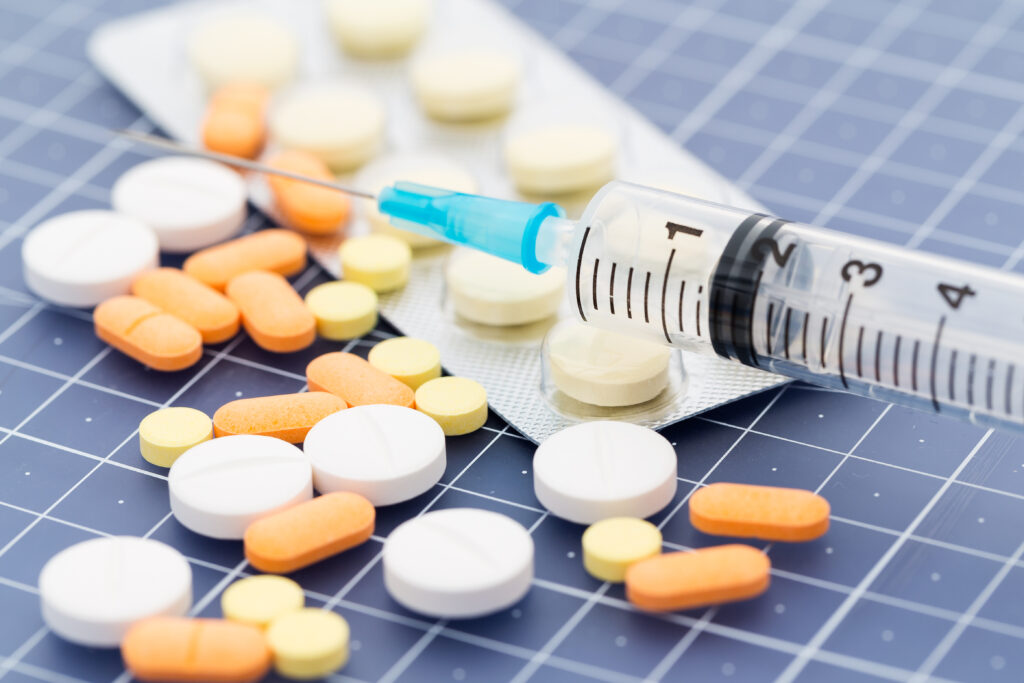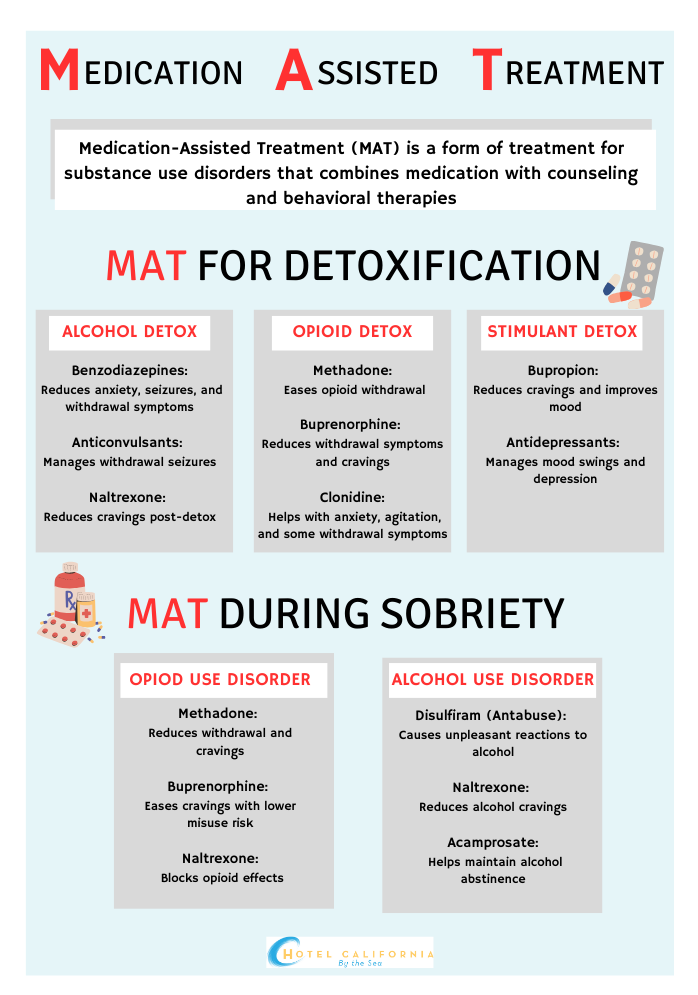What is MAT?
Substance use disorder and alcohol addiction are some of the most difficult and sometimes dangerous conditions to overcome. There are many types of treatment methods used to help combat these diseases. One of the most effective methods is medication-assisted treatment. It is also known as MAT. MAT is a type of treatment method that incorporates psychotherapeutic behavioral therapies such as cognitive behavioral therapy (CBT) and dialectical behavioral therapy (DBT) in addition to specific FDA-approved prescription medications. It is most often used to help treat and ease intense withdrawal symptoms as the body recalibrates and adjusts to normal without the presence of drugs.

The medications used are targeted and utilized to manage very specific symptoms of substance use detox and withdrawal. It can be very beneficial for those with severe cases of addiction and for those who need more time to safely stop using addictive substances. The purpose of MAT is to help ensure that those who are struggling with a substance use disorder, can go into recovery with as many tools as possible to achieve their goals of recovery and lifelong sobriety.
Medication-Assisted Treatment: What is MAT?
What is MAT? MAT is defined as an ongoing and long-term treatment approach utilizing FDA-approved medications. MAT is a whole-patient approach to treating substance addiction by utilizing behavioral therapies as well as medication to treat conditions such as opioid use disorder and alcohol use disorder. Patients who are addicted to heroin or prescription pain relievers are often treated using MAT and have had successful outcomes. This is because MAT is not a stand-alone treatment modality. It is also used in combination with various types of behavioral therapies and psychosocial support treatments.
MAT wasn’t always as widely acceptable as it is today. In fact, there was much stigma associated with the treatment method. Many believed MAT was essentially replacing one drug for another. However, this is not the case.
In the past doctors and clinicians who were helping patients with their substance use disorders would try utilizing extended hospital stays, aversion therapy, or even threats of incarceration. However, these were all failed attempts at trying to keep patients from relapsing on heroin and other types of addictive opioids. No matter what type of treatment was received, patients would continue to relapse. This was until the late 1960s when doctors realized after talking to patients that they felt miserable both physically and mentally after detoxing. These feelings often prompted patients to go back to using in order to alleviate the discomfort of early sobriety. This was when MAT was introduced as a treatment method.
Today MAT is considered the standard of care for treating conditions such as opioid use disorder and in some cases, for alcohol use disorder. There has been over decades of research and studies done on the benefits of utilizing MAT. It is one of the most effective treatment methods in medication. It can also treat severe conditions of high risk of overdose, death and social disruption.

Common MAT used for treating Opioid Use Disorder
In 2020, almost 75% of fatal drug overdoses were associated with opioids. Opioids, specifically synthetic opioids, have caused a decades-long public health drug crisis that is still ongoing today. Opioid use disorder is defined as the inability to control opioid use despite continued negative consequences such as injury and illness. Commonly abused opioids include codeine, hydrocodone, oxycodone, morphine and fentanyl.
When in treatment, withdrawal symptoms from opioids during the detox phase can be some of the most difficult to overcome. Opioid cravings can be challenging to manage, especially for those who have had long-term use of the drug or who have severely abused the drug. Some of the withdrawal symptoms can become dangerous and include vomiting, diarrhea, fever, muscle aches, tremors, insomnia, anxiety and depression.
This is where MAT has proven to be one of the most effective treatment methods when it comes to substance addiction. MAT helps to normalize and re-balance brain chemistry by blocking the effects of opioids and relieving some of the physical cravings with all the negative effects of highly addictive opioids.
Methadone – Methadone is one of the more well-known MAT medications. It helps to reduce opioid cravings and withdrawal symptoms. It can block the effects of other opioids including feelings of euphoria. This helps reduce motivation to use other opioids. Methadone is a medication that must be taken daily and under clinical supervision. It is only dispensed by federally registered Opioid Treatment Programs.
Buprenorphine – Buprenorphine is a partial opioid agonist that helps to reduce physical dependency and minimize or prevent withdrawal symptoms and cravings. It is prescribed by a medical provider and can be taken at home or in a clinical setting. It can be a safer alternative to methadone. The use of buprenorphine for OUD treatment allowed treatment providers to greatly expand the availability of these life saving medications beyond what methadone clinics were able to offer its patients. While still an opioid with the potential to become addictive, when taken as prescribed and monitored, it is considered a safe treatment option.
Naltrexone – Naltrexone is a medication that is used to block the euphoria and sedative effects of opioids. This is helpful for patients who are trying to stay motivated in recovery and helps to prevent and reduce the risk of relapse. Naltrexone is an opioid blocker and prevents opioids from affecting the body.
Naloxone – Naloxone is an emergency medication used to prevent or reverse opioid overdose. It reverses the effects of an active opioid overdose. It is a temporary medication and not meant for long-term use. Once the medication has been administered, patients should seek medical attention immediately after.
Check Your Insurance Coverage for FREE
Find out if your insurance covers addiction treatment in minutes. We accept most insurance!
Common MAT used for treating Alcohol Use Disorder
Alcohol use disorder is one of the most common mental health conditions across the country and globally. Over 85% of Americans reported alcohol use at some point in their lives. In fact, alcohol is consumed at such a considerably high level that now many MAT programs have been designed and created around treatment for AUD.
Acamprosate – Acamprosate is a prescription medication that helps reduce cravings to drink alcohol. It is often taken after completing detox and withdrawal symptoms.
Disulfiram – This medication focuses on the prevention of relapse of alcohol by inducing uncomfortable side effects such as nausea, headache and vomiting within 10 minutes of alcohol being consumed. Again, this medication is usually taken after detox and withdrawal have been completed to help prevent cravings and relapse.
Naltrexone – This medication blocks the euphoric effects of intoxication from alcohol. It helps patients to stay motivated during their recovery to maintain sobriety. This medication comes in a variety of formulations including daily or month-long injections.
Benefits of MAT
- Decreased opioids-related overdose deaths
- Improve patient survival
- Increased retention in addiction treatment
- Decreased illicit opioid or other drug use
- Decreased criminal activity among people with substance use disorders
- Increased patient’s ability to gain and maintain employment
- Improved birth outcomes
- Reduced the risk of transmission of bloodborne diseases such as HIV and Hep C
- Increased social functioning
- Helps to manage some physical aspects of addiction so it is easier to maintain recovery
- Has been proven highly effective in reducing relapse rates for those struggling in abstinence-based treatment programs
- Helps to restore and rebalance the brain, allowing it to heal from damage by drug use
Reach out to Hotel California by the Sea
We specialize in treating addiction and other co-occurring disorders, such as PTSD. Our Admissions specialists are available to walk you through the best options for treating your addiction.
Do you need treatment for Opioid Use Disorder or Alcohol Use Disorder?
MAT is one of the most effective treatment methods when it comes to treating substance use disorders. It is especially beneficial when treating opioid use disorder and alcohol use disorder. Despite decades of positive research and studies, it is still not a widely used treatment method. Stigma and misconceptions about replacing one drug for another have contributed to the resistance to using MAT. The goal of MAT is to help patients recover from their addiction by providing a safe and controlled level of medication to help them gradually overcome their use of an addictive substance. There are behavioral health treatment programs such as Hotel California by the Sea that utilize MAT as part of their program in helping to support clients as they recover from their addiction.
We provide varying levels of care including detox, inpatient residential, partial hospitalization program and intensive outpatient program. Throughout each level of care, patients may require MAT alongside intensive psychotherapies including CBT, DBT and EMDR therapy. The combination of different treatment methods helps to ensure clients receive evidence-proven treatment to help them overcome their addiction and live a happier and healthier life in sobriety.
References:
https://www.addictioncenter.com/treatment/medications/medication-assisted-therapy
https://dph.illinois.gov/topics-services/opioids/treatment/mat-faq.html
https://www.naco.org/resource/osc-mat
https://www.ochealthinfo.com/sites/hca/files/import/data/files/67154.pdf
